
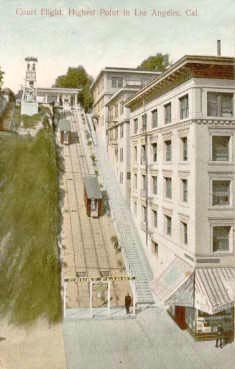
A Visit to Old Los
Angeles
8. Broadway (Part 2).
by
Brent C. Dickerson
Copyright © Brent C. Dickerson
Index to Episodes (click here)
Strolling south down Broadway from Temple Street to Fourth Street.
• Across the street from the
County Court House is the convenient Hotel Broadway, and its adjoining and
even more convenient Court Flight funicular railway and flight of steps
going up to residential Hill Street.
 |  |
• The view east from the roof of the Hotel Broadway. Note the upper-floor connections between the new Hall of Records and the old Court House. Just to the right of the Hall of Records, Franklin Street inconspicuously opens out on Broadway.
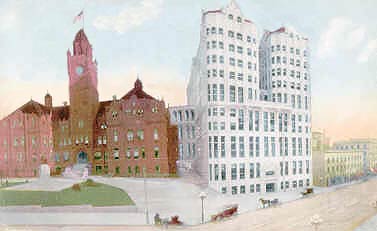
• The rest of the west face of Broadway just north of First Street; Broadway's intersection with First Street is at mid-left in this view. The trees at lower left show that this picture was taken before the new Hall of Records was constructed. Just beyond the trees, we see the wall-sign of the Times-Mirror press building, where the Los Angeles Times was published. Across the street from the Times's building you can see a large building with many dormer windows. It's at the northwest corner of Broadway and 1st Street, and is called the Tajo Building. The Tajo Building was built by Simona M. Bradbury, widow of Lewis Leonard Bradbury (of the Bradbury Building further down Broadway); the name Tajo comes from Mr. Bradbury's mine of that name in Sinaloa, Mexico. This building hosted the Federal Courts for a short time.

• These buildings faced the imposing mass of the Los Angeles Times building. Beyond, in the distance, we can pick out a little of a building we saw when we visited "east of Main St."—the Los Angeles Soap Co.'s building.
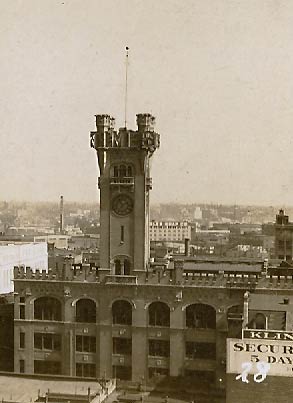
• Right across the street from the Los Angeles Times premises could be found, at 113 N. Broadway, the Southwest Turquoise Company, which declared itself to be the "Largest Gem Cutting House on the Pacific Coast." Anna sighed, "Must they be cut? Surely gems are more beautiful in the state Nature left them." "Oh, Anna!," said Minnie, "at times like this, I think you're in the state in which Nature left you." Quoth Papa, with a sigh of his own, "No bickering, girls."

• Now we are next to the
Times building as we approach the corner of First Street, which a few
yards to the west of the intersection begins to ascend to Hill St.; but we
will continue south down exciting Broadway . . .
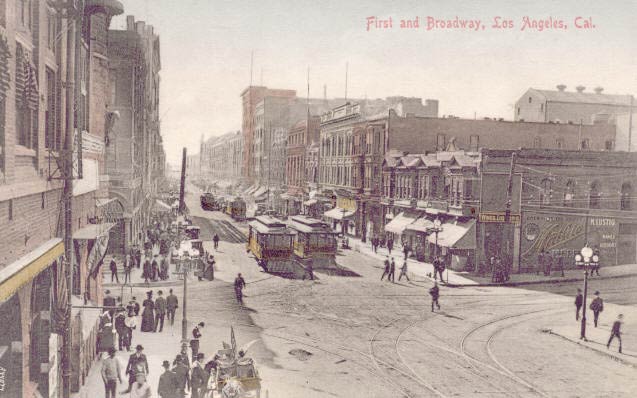
• As we cross 1st Street, we look east back towards its intersection with Spring St. On the far side of the Times Building—which is looking rather the worse for wear, having just been blown up by Unionist terrorists—we see the other structures on the north side of 1st Street. Recalling our visit to New High Street, it is behind these buildings that New High Street comes to its south end at Franklin Street.

• The north face of First Street, across from the Times Building, looks—in a rather darksome way—like this. The Nadeau Hotel at the southwest corner of First and Spring Sts. dominates at left; the building with the Bull Durham wall-sign at upper right is at the southeast corner of First Street and Broadway. A piece of the Times Building itself dominates at right.
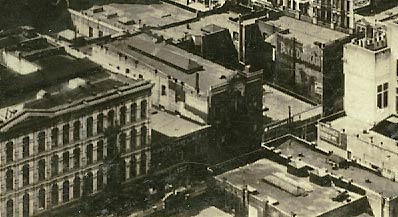
• We finish crossing First
Street, and turn to look back north up the east side of Broadway. The
Hall of Records in the distance conceals the Court House. Immediately
before us, at the northeast corner of First and Broadway, is the Los
Angeles Times building, in better shape than it was a moment
ago.
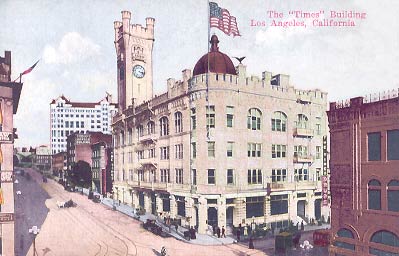
• Papa turns to the south
again, and declares Broadway "A fine looking street, boys," and stands
there several minutes contemplating it, as Mother wonders why we must
spend all the days walking up and down streets. The Chamber of Commerce is
near at hand at the left; the tower of City Hall looms
ahead.

• The Neuner Company's headquarters would be found just a few storefronts down the west side of the street, at addresses 113-115. One of the first businesses to locate to Broadway as it became urbanized, it would remain in its old building even as this stretch of Broadway began to decline.
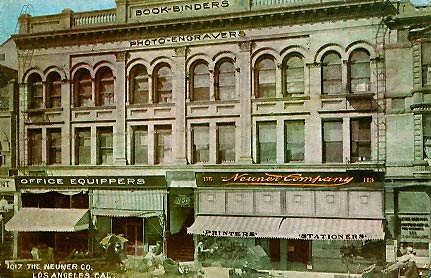
• The Los Angeles Chamber of
Commerce building, on the east side of the 100s block of Broadway. The
building, also known as the Southwest Building, had 130 S. Broadway as its
address; the Chamber of Commerce, which moved here in 1903, and stayed
until January 31, 1925, used 138 S. Broadway as its address. Previously,
the Chamber, founded in 1888, had been sited initially on N. Main Street,
then at what was to become the Tajo Building lot at 1st and Broadway,
moving in 1890 to the Mott Building at 131 S. Main Street, and moving in
1894 to the then-new Mason Building at the southeast corner of Broadway
and 4th.
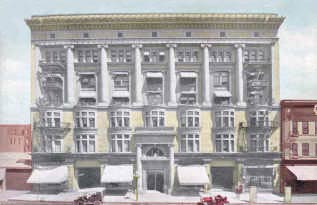
• Let's go in, shall we?
Hm!—agricultural produce galore . . .
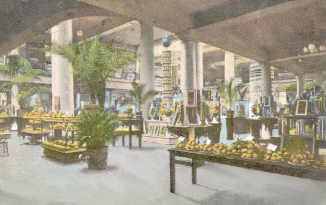
• Mother said that she could
die in peace now, knowing that she had seen an elephant made out of
walnuts. This elephant was made—of California walnuts—to call
attention to Southern California and Los Angeles at the 1893 Chicago
World's Fair.
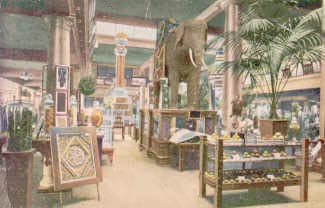
• —And Anna added that
not many people will have seen a tortoise climbing a
wall.

• I looked out the front window, and noticed the Mason Opera House almost directly across the street (it was built in 1902-1903 by John Mason, opening in June of 1903). "I saw an opera once," said Charley; "my collar was too tight that evening." From behind a pyramid of grapefruit, Minnie called out, "Only our Charley could go to an opera and have nothing to tell but how tight his collar was."
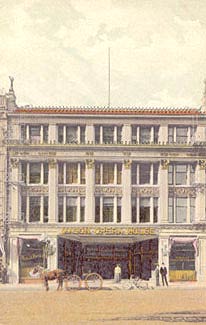
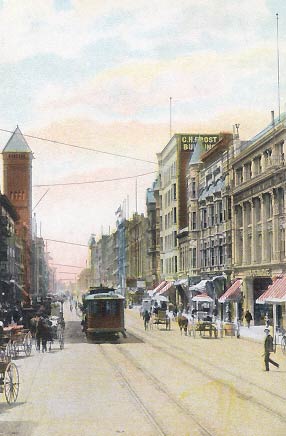 | • The west face of Broadway to Second Street and beyond, seen from in front of the Chamber of Commerce building. The Mason Opera House is at extreme right. |
| • We leave the Chamber of Commerce building, and look back at it and the building just south of it. "Ulf," quoth Minnie, "use of the neck in people should be different from use of the neck in owls." "I will take that advice to heart," quoth I. |
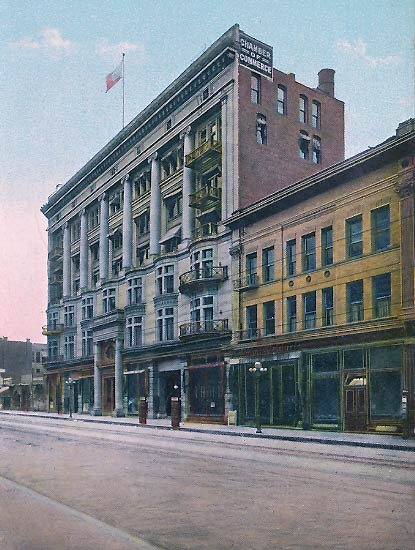 |
• The corner of Broadway and Second Street, where in one view, we look south down Broadway, and in the other we take a closer look at the corner's buildings.
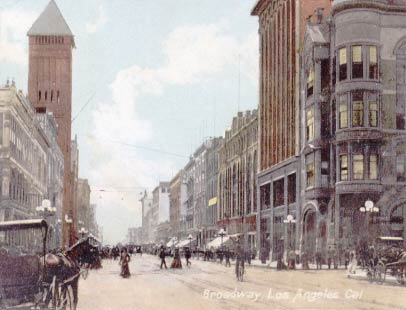 |
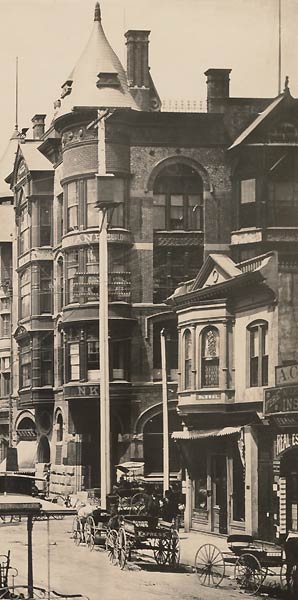 |
• A better look at the west side of the 200s block of S. Broadway. The old-fashioned building closest to us is another branch of the American Savings Bank, alias the American National Bank; indeed, this building was known as the American National Bank Building.
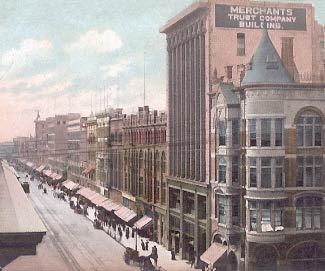
• I wanted to send you a postcard of the American National Bank Building, as what speaks of romance more tenderly than fiscal attentiveness? (Minnie was looking over my shoulder as I wrote this, and exclaimed, "Oh, Ulf—I always knew you had a silver tongue!") In the street's residential days, the lot the bank is on hosted the town home of Jotham Bixby (we will hear of the Bixby family again when we visit Long Beach).

• The American National Bank Building would be replaced by the California Building, seen here at center. The tawny building dominating at right is the C.H. Frost Building, completed in 1898.
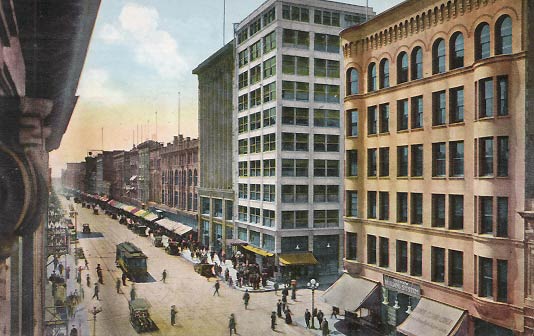
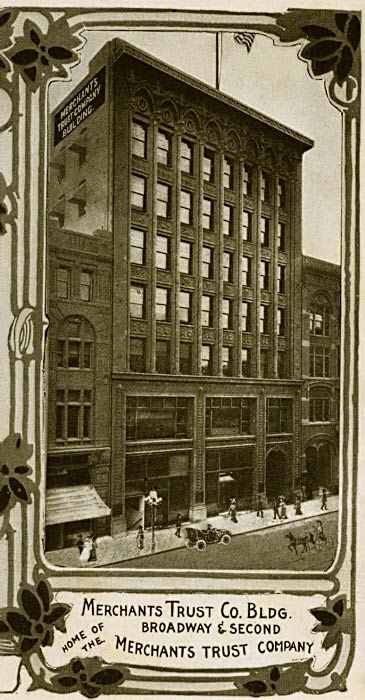 | • Immediately to the south of the American National Bank Building is the Merchants Trust Company Building. "Charley, my boy," began Papa, "just what would you say a Merchants Trust Company would do? It sounds to me, to me it sounds . . . ," and he stopped to ponder just how it sounded to him. "Tedious?", suggested Charley. "Sinister?" was Minnie's idea. "Sacerdotal?" was what I floated; but Mother cautioned, "Watch your language!". Anna simply looked at him expectantly. ("Please, Ulf," Minnie said to me as I wrote, "say 'with anticipation', not 'expectantly'.") Young Frederick Johan offered, "It sounds not worth the time to think about it?" "Ja, dat's it!" shouted Papa. |
• We take just a few more steps south. The tower of City Hall looms larger and larger.

• A better look at the east side of the mid-200s on S. Broadway. The building this side of City Hall, at 218 S. Broadway, is the Copp Building. On the site of the Copp Building was the first synagogue of Los Angeles, a brick building of 1873.
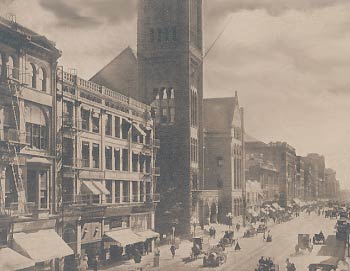
• The 200s block of Broadway
brings us the elegant Los Angeles City Hall.
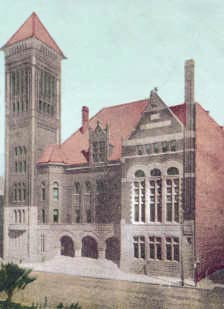
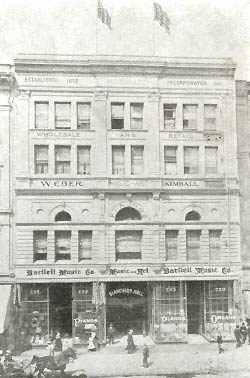 | • At 231-233-235 S. Broadway, directly across from the City Hall building, is Blanchard Hall and the Bartlett Music Company, on the site of one of the successive homes of Harris Newmark, a pioneer of 1853 who became one of the most influential and important citizens of the growing city, also writing a fascinating book on the city, people, and occurrences of his time. As we were looking in the window, a clerk came out. "Interested in music?," he asked Papa, who proudly threw back his shoulders and said, "Yes, I should think so, indeed I should. Why, my family can give you the scale a capella as we stand right here before you, sir!" "That a fact?" said the clerk. "Oh, no," muttered Minnie, under her breath. "Folk, let's hear it. Do," he began. Mother took it up with "Re," while Charley bellowed a "Mi" which caused heads across the street to turn. Anna's "Fa" was a very quiet one; Minnie's "So!" was very characteristic. My "La" was nothing less than incomparable, poorly followed, I must say, by young Frederick Johan's merely competent "Ti." All eyes turned to the Baby, who finished the scale with a robust "Waaah!". As the clerk stared numbly, I said "I'm sure you've never heard a better 'Do-Re-Mi-Fa-So-La-Ti-Waaah'...?" He took a deep breath, and said, "We're closed for lunch" as he shut the door behind him. |
| • Next door to the south was J.W. Robinson's Boston Store. "I do say, folk," Papa allowed, "that this fine establishment certainly has the 4th of July spirit." Minnie was dubious: "A bit early, isn't it?, with a week or so to go? I suppose that next year, they'll start festooning for the 4th the day after Christmas!" "Why not leave the decorations up all year?," was young Frederick Johan's question; "after all, we never stop being Independent." Papa beamed, "That's my boy!" |  |
• At Third Street and
Broadway, we climb to the top of a building and look back north (left); we
blink, and the new Hall of Records has been built, obscuring the Court
House and closing in the cityscape (right). In either case, we see the
Broadway Tunnel through Fort Hill at the far end of the street; and we
remember again that Broadway's previous name was "Fort Street." The
3-story building close to us at the right margin of the left-hand view
is the Rindge Building, while the building we see at the left margin of
both views is the Byrne Building.
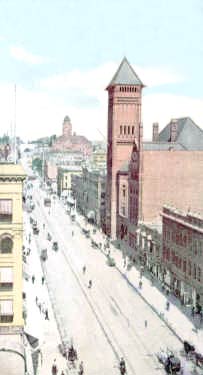 | 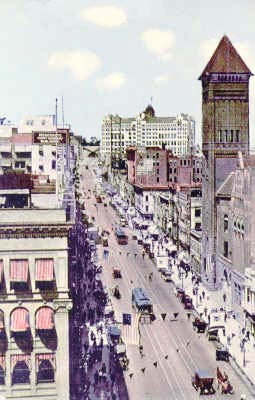 |
• Let's descend to street-level, and take in a bit of the west face of Broadway north of Third. That's City Hall with the flagpole angling out of the wall near top center of this view.
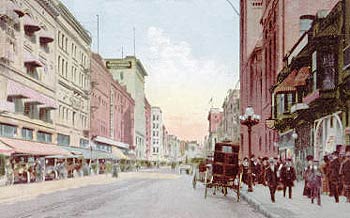
• A better look at the Byrne Building, at the northwest corner of Broadway and Third Street. We see a bit of the wall, and wall-sign, of the Boston Store at the center right edge.
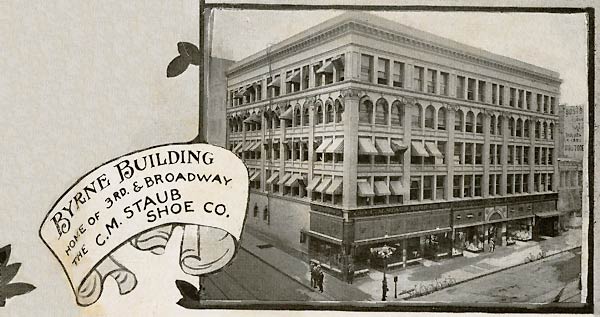
• "What's that old building on the southeast corner?", I asked. "'Bradbury Bldg.', it says," came young FJ's voice, seemingly from thin air. "Perhaps we could take a look inside...?", I floated. Minnie scowled, "Oh, gracious grandmothers! Do let's move along." "It doesn't look very promising, Ulf," was Charley's opinion; "I haven't seen a single sweet young thing go in at all." "But it might be interesting inside!" But by this time, everyone but Anna was already half a block ahead. She took my hand and said, "I think you've been outvoted."
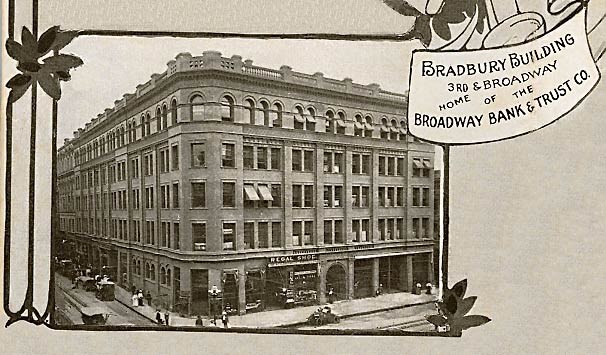
| • As we reviewed the day at the dinner-table that evening, young FJ said, "I did look inside!" "No, you didn't," quoth I; "you were everywhere but there." "Oh, yes I did. But I think they weren't done building the place. It was all wide open spaces." Anna said, "What if they built a building and forgot to give it an inside?" "I'd think that, if a body weren't outside a building, then a body would have to be inside a building, just because there's nowhere else to be," said Aunt Sigrid, as she handed around the potatoes, "So there would have to be an inside." "Well," said Papa, "I think you could be in Sweden, in a field, planting carrots, and not be inside that building, and not be outside that building." "What about potatoes?", asked Aunt Sigrid. "Ja," said Papa, "you could be planting potatoes too. But I don't think they grow good there." Mother held a hand to her temple. "My head is spinning...", she said. "Mother," said Minnie, "I find it's best not to listen. It upsets the digestion." | 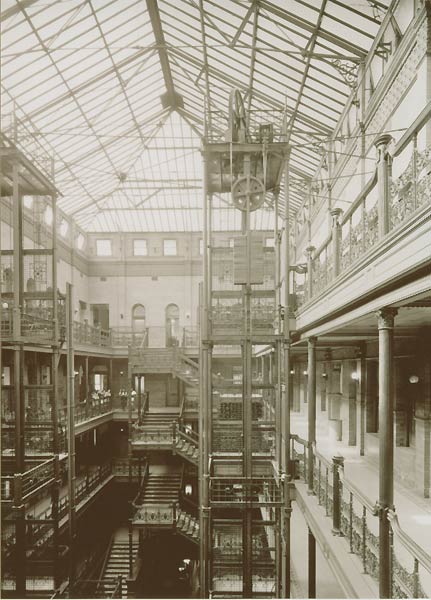 |
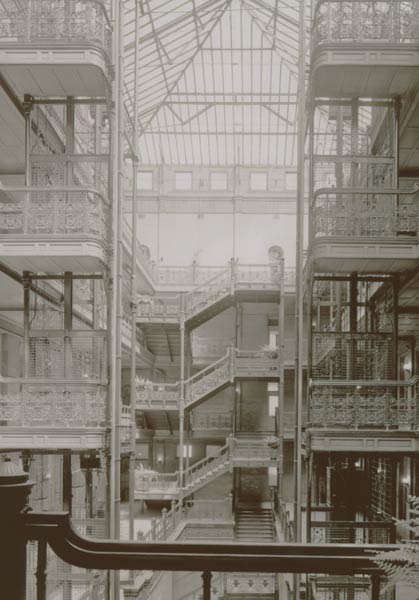
| • Charley picked up his fork and waved it gracefully in the air as he spoke. "Just for the sake of discussion," said he. "—Remember, Mother: digestion!", said Minnie. "Just for the sake of discussion, let's say that you were planting carrots and potatoes in a field in Sweden, while meantime Ulf was opening the door to this building in Los Angeles. When he opened the door, what would he find?" "Nothing!", declared Papa, firmly. "How do you figure?" "If I was planting potatoes and carrots in a field in Sweden, there wouldn't be an Ulf or nobody here, and Mrs. S would have married a fat French wheelwright in Missouri." Mother looked hurt. "He wasn't fat. He was strongly built. He was very good with a hammer." "Maybe he could build something to fit inside this building," FJ proposed. I said, "I'm not sure we've established that it has an inside." "Well, all this talk," said Anna, "I'm sure that my insides are feeling empty, and probably yours are too." "Not Minnie's," sniffed Charley. |
• About a third of the way down the 300s block will be found the Homer Laughlin Building, constructed in 1896 [at present, it houses the Grand Central Market]. Mr. Laughlin amassed his fortune in Ohio with his Homer Laughlin China Company; he retired to Los Angeles in the 1890s, bought the home and lot of Mrs. Samuel Briggs on Broadway, and built this building on the site, said to be the first fire-proof building in L.A.

• We go to the corner of
Fourth Street, and turn and look north at the west side of the street. The
nearest building which has a flag flying over it is the Laughlin Building.
The building at the left edge is the Zobel Building. We can see shops for
an optician, a shirtmaker, a portraitist, a milliner and dressmaker . .
.
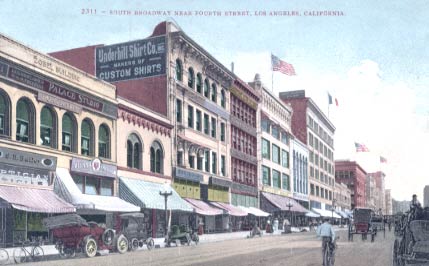
• One of those shops is H.J. Whitley & Co., at 345 S. Broadway, "the largest jewelry store on the Pacific Coast," as their advertising would have it. "No doubt they 'can offer low prices due to their quantity sales to our many satisfied customers'," said Papa as we passed the store. "'Service with a smile!," added Mother. "'Nature's miracles,'" read Anna, "'prepared to your exacting standards by our renowned old-world craftsmen!'." "'Your credit good here,'" was Charley's contribution. I offered, "'Don't let others cheat you; come here first!'." Minnie, shopping the store windows, sighed, "Why, oh why, must I always have the feeling that I'm traveling with a vaudeville troupe?". Young Frederick Johan, several steps ahead as usual, shouted, "On with the show!". The baby had no comment.
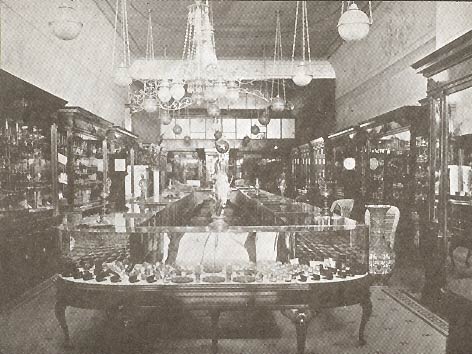
 | • The modest building at 340-342-344 S. Broadway. |
• Looking from the north, with Broadway going south into the distance, we see, at the center of this view, the east side of the corner of Broadway and Fourth Street. The O.T. Johnson Building is at the northeast corner of this intersection, while the Mason Building is at the southeast corner. The wall-sign of the Grant Building is prominent at the right side of this image; it's at the northwest corner of this intersection. Near the left edge, about two-thirds of the way up, we can see just a bit of the wall-sign of the Angelus Hotel at the southwest corner of Spring and Fourth. While the printed caption of this view states "Broadway looking South from 3rd," and likely the photographer was standing in a window near the top of the Byrne Building at Broadway and Third to take the picture, most of the view is of Broadway looking south from Fourth.
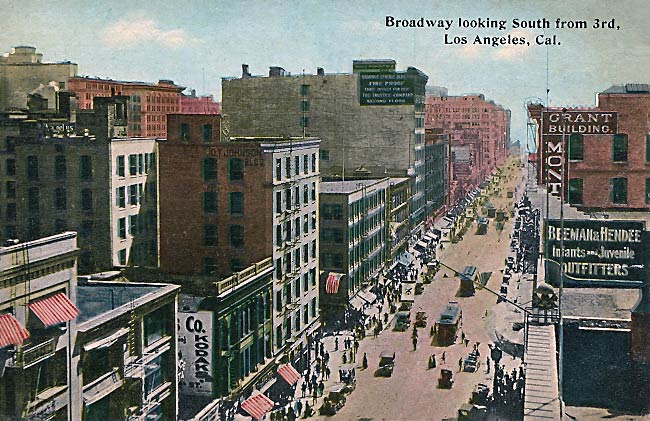
• A street-level view from nearly the same point, and a few years later.
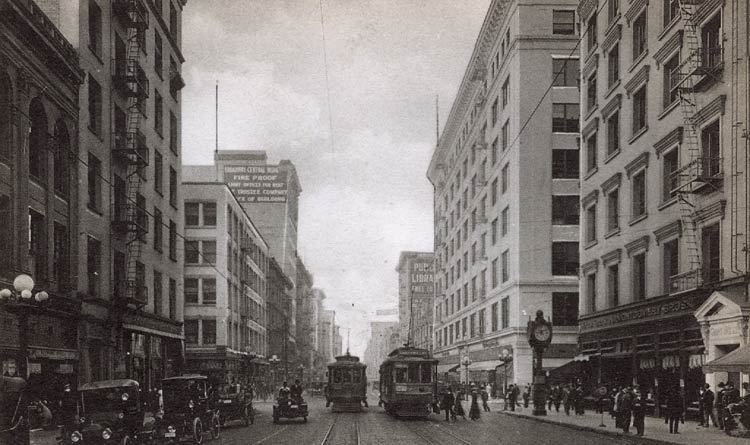
• Catching up with young FJ at the
corner with Fourth Street, we looked back north at both sides of
the street. A fine-looking street in this direction, too! The
building at the right edge of the view is the O.T. Johnson Building, built
in 1906.

• But what is that hulking over
us at the top of the building at left (which is the Grant Building, built
in 1902)? Let's take a few steps back for a better view. Oh, of
course—it's a lady's shoe!
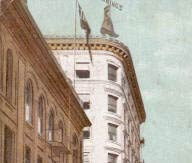
• Across the street from the shoe, that is, at the southwest corner of Broadway and Fourth, is the Broadway Department Store (grand opening, May 6-11, 1907), the original of a chain of department stores very well known in Southern California throughout the Twentieth Century, and at length assimilated by Macy's.
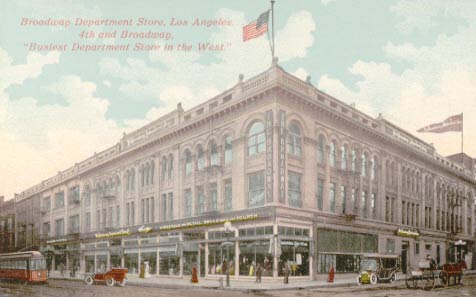
• The ever-changing kaleidoscope of Broadway at Fourth! Sometimes busy—must be mid-day . . .
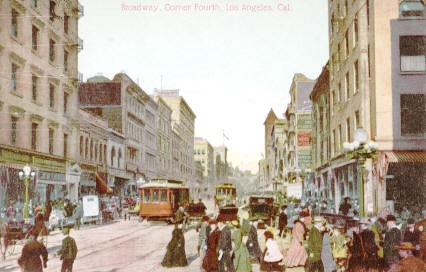
• . . . And sometimes quieter. The shadows tell us it must be about 10 a.m. The building of which we see a portion at the extreme right edge of this view is the Mason Building, which broke ground in 1893 and opened in 1894. Its owner was George Mason. The building hosted the Chamber of Commerce from 1894 to 1903; it was sold by Mason's heirs in 1922.

| • On the ground floor of the Mason Building, as young Frederick Johan eagerly pointed out to us, was a photography shop. "Wouldn't it be interesting," floated he, "if we were all to have cameras, so we could compare different pictures?" In the matter of floating, this sank. Mother spoke simply, but eloquently: "Pictures? Bah!" | 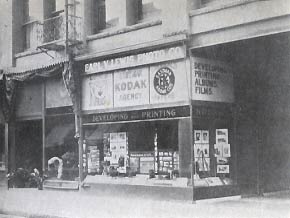 |
• Suddenly, Minnie grabbed Papa's arm and led him to a storefront window. Out loud, Charley read the sign—Pin-Ton Candy Store, 427 S. Broadway. "Walk on," cried Mother; "sweets only to the sweet, Minnie dear." Papa winked at Charley.

Return
to Broadway part 1 and New High St.; or on to Broadway
part 3 . . .